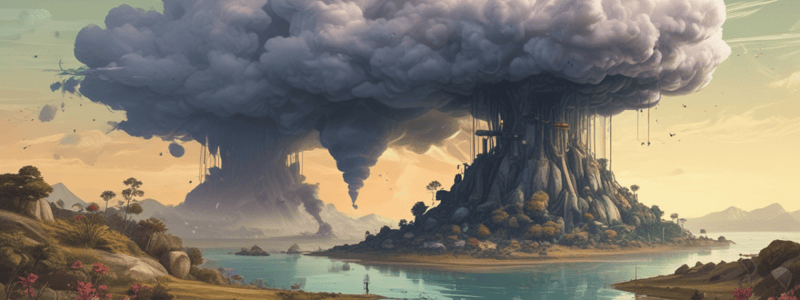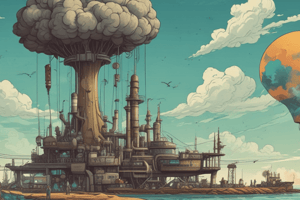Podcast
Questions and Answers
What is one of the primary causes of water pollution mentioned in the text?
What is one of the primary causes of water pollution mentioned in the text?
- The use of natural products to accomplish tasks
- Using cleaner forms of energy
- The disposal of raw sewage directly into a landfill
- Litter, such as plastic bags and bottles, entering the watershed (correct)
What is the definition of land pollution?
What is the definition of land pollution?
- The presence of physical objects in the environment
- The presence of toxic substances in soil or litter (correct)
- The presence of toxic substances in air or water
- The presence of greenhouse gases in the atmosphere
What is one way to reduce pollution, according to the text?
What is one way to reduce pollution, according to the text?
- Recycling products and goods (correct)
- Increasing the use of fertilizers and pesticides
- Using fossil fuels to generate energy
- Disposing of raw sewage directly into a watershed
What type of pollution occurs when materials or objects are introduced into the environment, causing toxicity or harm?
What type of pollution occurs when materials or objects are introduced into the environment, causing toxicity or harm?
What is a common byproduct of industry that is a chemical pollutant and can weaken the immune system?
What is a common byproduct of industry that is a chemical pollutant and can weaken the immune system?
What is an example of biological pollution mentioned in the text?
What is an example of biological pollution mentioned in the text?
What can indicate contamination from humans in water?
What can indicate contamination from humans in water?
What can occur when fertilizers run off into water supplies?
What can occur when fertilizers run off into water supplies?
What is pollution?
What is pollution?
What are the five recognized categories of pollution?
What are the five recognized categories of pollution?
What is the primary cause of air pollution?
What is the primary cause of air pollution?
What is light pollution caused by?
What is light pollution caused by?
What is environmental pollution?
What is environmental pollution?
What is an example of environmental pollution?
What is an example of environmental pollution?
What is a cause of air pollution?
What is a cause of air pollution?
Flashcards are hidden until you start studying
Study Notes
What is Pollution?
- Pollution is the act of releasing harmful or damaging substances into the environment, known as pollutants.
- There are five recognized categories of pollution: air, land, water, noise, and light.
Types of Pollution
- Air pollution is caused by the release of harmful gases into the atmosphere, such as soot or ash from burning substances and toxic gases like carbon dioxide from fossil fuels.
- Land pollution is defined by the presence of toxic substances in soil or litter, including litter, fertilizer runoff, oil spills, and raw sewage disposal.
- Water pollution is caused by factors such as litter, fertilizer runoff, oil spills, and raw sewage disposal.
- Noise pollution is caused by the noise of a busy environment, such as a city.
- Light pollution is caused by the cumulative effect of many lights on the night sky, disrupting nocturnal animals' environments.
Environmental Pollution
- Environmental pollution is the damaging effect of human activity on Earth, specifically land, air, and water.
- Examples of environmental pollution include air, water, and soil pollution.
- Human activities, such as burning fossil fuels and releasing toxic gases, contribute to environmental pollution.
Reducing Environmental Pollution
- Using cleaner forms of energy can reduce air pollution.
- Recycling products and goods can reduce waste and keep materials out of landfills.
- Using green products, or natural products, can replace harmful chemicals and reduce pollution.
Physical Pollution
- Physical pollution occurs when materials or objects are introduced into the environment, causing toxicity or harm.
- Examples of physical pollution include litter, such as incorrectly disposed of water bottles, and landfills.
Landfills
- Landfills are designated areas for trash disposal, lined with a waterproof barrier to prevent soil contamination.
- Landfills contribute to pollution by releasing greenhouse gases and contaminating surrounding soil and land.
Chemical Pollution
- Chemical pollution is the release of harmful chemicals into the soil, air, or water by humans.
- Examples of chemical pollutants include mercury, volatile organic compounds (VOCs), carbon monoxide, and sulfur dioxide.
- Chemical pollutants can come from industrial waste, fertilizers, pesticides, and chemical factories.
- Dioxin is a particularly harmful chemical pollutant that weakens the immune system and affects seed development in plants.
Biological Pollution
- Biological pollution consists of substances derived from nature that cause human harm.
- Examples of biological pollutants include pollen, bacteria, and human fecal matter.
- Biological pollutants can adapt to the environment and indicate contamination from humans.
Studying That Suits You
Use AI to generate personalized quizzes and flashcards to suit your learning preferences.




